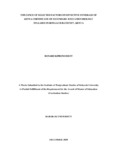INFLUENCE OF SELECTED FACTORS ON EFFECTIVE COVERAGE OF KENYA CERTIFICATE OF SECONDARY EDUCATION BIOLOGY SYLLABUS IN RONGAI SUB-COUNTY, KENYA
Abstract
The need for effective coverage of secondary school syllabi is crucial in Kenya and the
world at large. This study sought to determine effective coverage of KCSE Biology
syllabus in secondary schools in Rongai Sub County. The study objectives include to
determine the influence of student related factors, teacher related factors, availability of
instructional resources and Time management on effective coverage of KCSE Biology
syllabus in Secondary Schools in Rongai Sub-County, Kenya. The study was grounded
on curriculum implementation theory and espoused correlational design. The study was
conducted in Nakuru Rongai Sub-County secondary schools. The target population of
this study encompassed 151 Biology teachers, 60 principals and 120 form four class
secretaries. Census method was used to sample Biology teachers and class secretaries
while purposive sampling technique was used to sample head teachers. In this study,
content validation of the questionnaire was determined by research supervisors from
Kabarak University who read the content, look at the items and ensured that they reflect
the actual content area. This study used test retest method of determining reliability of
research instrument. The instruments were piloted in Ndongeri Mixed secondary, Upper
hill mixed and Njoro day secondary school. Data was obtained using a questionnaire and
an interview schedule. Data was first analyzed using descriptive statistics while Pearson
Correlation coefficient was run to determine the existence and significance of the
relationship between independent and dependent variables. Also, Regression statistics
was used to determine the influence of independent variables on dependent variable.
Equally, interview data was analyzed systematically by organizing the responses into
themes which was then presented in prose form. Hypothesis was tested at 0.05 alpha
level. Data was then presented in form of pie charts and tables. The findings revealed
that student related factors significantly influence effective coverage of Biology syllabus
(β = 0.290; p<0.05). Similarly, teacher related factors significantly influence on effective
Coverage of Biology Syllabus (β = 0.390; p<0.05). Furthermore, availability of
instructional resources significantly influences effective coverage of Biology Syllabus (β
= 0.44; p<0.05). Finally, time management influence negatively effective coverage of
Biology Syllabus (β = -0.14.8; p>0.05). The study concludes that students’ perception
towards Biology, students’ participation in class especially in extra research on topics
learnt influence effective syllabus coverage. Moreover, teacher transfers and negative
perception towards some topics influence effective syllabus coverage. Besides,
availability of science laboratory equipped with reagents and materials, adequate
textbooks and physical classrooms influence effective syllabus coverage. Finally, it was
noted that adequate time allocated in the timetable for teaching influence significantly
effective syllabus coverage. It is herein recommended that Teacher transfers should be
managed appropriately in order to improve effective coverage of Biology Syllabus. Inservice
training of teachers as well as adequate equipping with new technologies,
pedagogical techniques and appropriate instructional resources should be underscored in
order to achieve effective coverage of Biology syllabus. Finally, school management
should emphasize on strategies geared towards management of instructional time in
order to boost effective coverage of KCSE Biology Syllabus.

